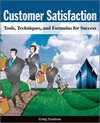 |
The Sound of All Hands Clapping: Use recognition
to build a better organization
By Craig Cochran
All humans crave recognition. It’s a universal need.
Whether you’re a manager in Atlanta or a mechanic in Burnley, you
want others to notice your efforts. Simply put, getting recognized feels
good. We’re all aware that employees benefit from recognition, but
we tend to forget that organizations benefit just as much from recognizing
their employees. What are some of the benefits to both employees and their
companies? Let’s take an inventory:
| • |
Employees receive unequivocal feedback on their performance. |
| • |
Employees understand that their efforts make a difference. |
| • |
Employees’ pride and self-esteem are reinforced. |
| • |
Organizations receive greater motivation and effort from recognized
employees. |
| • |
Employees see that their organization values its people and cares
about their success. |
| • |
Employee performance increases as personnel strive to perform in
a way that receives recognition. |
| • |
Employees feel more loyal to their organization. They begin to feel
that they are part of the organization, as opposed to simply being
employed by it. |
| • |
Employees are willing to work harder and better in a way that money
can’t buy. |
| • |
Organizations increase their advantages over competitors. |
Clearly, recognizing employees makes good business sense, but it can
be a complicated issue. With the best of intentions, organizations often
implement recognition systems that backfire and create effects exactly
opposite to those intended. Embracing the following principles will ensure
that recognition achieves the desired results.
Recognition should be:
| • |
It must be done
in front of the larger organization. This might constitute a department,
division, facility or the entire corporation. The type of recognition
will obviously influence the context within which it’s presented,
but it’s important to do so in front of a group. Recognition’s
public nature reinforces its significance for both the recipient and
the rest of the organization. A public event also means that the recognition
is done in person, not via telephone, e-mail, fax or some other remote
means. |
| • |
In order for
it to have a positive effect on organizational culture, recognition
must be available to anyone. Many companies implement recognition
policies but limit them to certain employees (e.g., production or
hourly personnel). The rationale, apparently, is that recognition
is important only to people in certain parts of the organization.
This is absurd, of course. Make sure your organization rewards the
efforts of all personnel, not just certain segments. |
| • |
It must fuel a feeling of
dignity in the person who receives it. This can be achieved by building
a ceremony, such as a company meeting or holiday dinner, around the
recognition. A degree of seriousness and formality is also helpful.
This doesn’t mean everyone must be stiff, humorless and dressed
in uncomfortable clothes, but the ceremony should be serious enough
so all personnel realize that special contributions are valued. |
| • |
It must have symbolic value,
something that lasts and can remind the recipient of the performance
being recognized. Keepsakes such as letters, certificates, plaques,
trophies and paperweights are very effective in this regard. They
provide motivation long after the recognition ceremony itself has
passed. My wife still displays her “East Ridge Hospital Nurse
of Excellence” plaque on our bedroom wall, more than 10 years
after she received it. I once asked her why she still displays the
plaque. “Because it makes me proud,” she responded. “It
means I can succeed at anything.” Years later, the symbolic
recognition continues to inspire not just motivation but pride as
well. |
| • |
Are people motivated by
money? Of course they are; that’s why most people work. But
exceptional performances are often motivated by something much more
complex and mysterious. Offering money as part of your recognition
policy cheapens it by attempting to affix a monetary value onto something
extraordinary. Not every effort, contribution, idea or suggestion
can be quantified. Organizations must recognize this fact and simply
provide honest, symbolic recognition. Issues of fairness also arise
when money becomes part of the equation. Instead of inspiring a culture
of continual improvement, monetary recognition often creates resentment
and rancor. Money can be an effective part of the recognition formula
only when it’s purely symbolic. |
Of course, sustained, outstanding performance should be matched with
increased compensation and promotions. If an organization has the
resources to increase its star performers’ pay, then it’s
wise to do so. But this is different from a day-to-day recognition
system. Keep it free of monetary awards and you’ll have far
fewer headaches.
|
| • |
This sends
the message that top management is aware of everyone’s contributions
and is thankful for outstanding efforts that lead to the organization’s
success. Especially in larger organizations, executives are somewhat
removed from individual performances. However, when an executive recognizes
the individual, it enhances the event’s significance and symbolism--and
it also helps to humanize the executive. |
| • |
Objective,
data-oriented criteria usually offer the best means to make decisions,
but this isn’t necessarily the case with recognition. Superior
performances take many forms; ensure your recognition system can capture
the full range of actions and performances that deserve recognition.
Don’t restrict its scope by declaring, “Here are the three
things that will trigger recognition.” Inevitably, a policy
of this sort will prevent you from recognizing someone who really
deserves it, simply because his or her performance doesn’t meet
the predetermined criteria. Give your system plenty of flexibility
and discretion. |
| • |
You’ve seen the awards
countless times: “Employee of the Month,” “Employee
of the Quarter” and so forth. With timeframes of this sort,
recognition becomes predictable and routine. There might not even
be any particularly outstanding performance during the month, but
it’s that time again… heck, just pick someone. Forced
decisions like this degrade recognition systems. In reality, organizations
might go months without identifying performance worthy of special
recognition, only to later run across half a dozen in one week. Recognize
personnel when performance, rather than the calendar, dictates it.
|
Now that we’ve considered how people should be recognized, we must
determine who will be recognized. What process can be used? Many organizations
form a management committee representing a cross-section of the company.
Generally, I oppose decision making by committee, but this is a workable
way to do it. A reasonably small committee of managers--no more than 10
people--meets regularly to discuss the special achievements of personnel
in their areas and agree on persons deserving recognition.
However, even better than having a management committee decide is to let
personnel do it. People who answer phones, package products, troubleshoot
equipment and service customers quickly spot which performances are worthy
of recognition. An easy way to capture their perspectives is through a
card system of some sort. Organizations put catchy titles such as, “We’re
writing you up… for being excellent.” on the cards, and provide
adequate space for relevant details. The cards are placed throughout the
facility or are available electronically. Anybody is authorized to complete
one, detailing the person to be recognized and what he or she did that
was outstanding. Completed cards are displayed on a wall or bulletin board,
and all those who were “written up” receive formal recognition
according to the guidelines already mentioned. Using the entire workforce
to identify outstanding performances offers a number of advantages. Among
other things, it:
| • |
Quickly builds an environment that is supportive and
team-oriented |
| • |
Accurately identifies outstanding contributions because those who
submit names have first-hand experience with the performances |
| • |
Results in more evenly distributed recognition, including people
who work within the less visible functions |
| • |
Addresses people’s need to feel involved and have their voices
heard |
| • |
Disproves the notion that management plays favorites when personnel
are recognized |
Displaying completed cards serves as a constant reminder not only of
the personnel who are recognized but also the system’s democratic
nature. The message is, “We support one another in our jobs and
take the time to provide recognition when it’s deserved.”
Few systems are as powerful as an effective recognition system. Because
its effect on organizational culture is significant and immediate, the
time and effort spent establishing such a policy for your company will
be repaid tenfold.

Craig Cochran |
About the Author:
Craig Cochran is a project manager with the Center for International
Standards & Quality, part of Georgia Tech's Economic Development
Institute. He's an RAB-certified QMS lead auditor and the author of
Customer Satisfaction: Tools, Techniques and Formulas for Success
and The Continual Improvement Process: From Strategy to the Bottom
Line, both available from Paton
Press. CISQ can be reached at (800) 859-0968 or on the Web at
www.cisq.gatech.edu. |
|
The Continual Improvement Process: From Strategy to the
Bottom Line
Continual improvement is not optional. It is a condition of survival.
Every organization must have systematic methods for making smart decisions,
attacking problems, improving its products and services, and repelling
competitors. Anything less than a systematic, disciplined approach
is leaving your future in the hands of chance. This book presents
a range of practical methods for driving continual improvement throughout
the organization. The starting point is leadership, with a clear definition
of mission, strategy, and key measures. These themes are then carried
throughout the enterprise, informing everyone on the issues that matter
most to survival and success. Strategic approaches for the deployment
of metrics, review of organizational performance, effective problem
solving, internal auditing, process orientation, and cultural development
are also described in detail. Practical tools and examples are provided
at every step of the way, enabling immediate implementation of the
concepts. This book is more than a guide to continual improvement;
it is a guide to leading and managing any organization. |
| 
Buy
Amazon
|
Customer Satisfaction: Tools, Techniques and Formulas
for Success
Customer satisfaction is the single most important issue affecting
organizational survival. Despite this fact, most companies have
no clue what their customers really think. They operate in a state
of ignorant bliss, believing that if their customers were anything
less than 100-percent satisfied they'd hear about it. Then they
are shocked when their customer base erodes and their existence
is threatened. The key to competitive advantage is proactively gauging
customer perceptions and aggressively acting on the findings. The
techniques for doing this don't have to be difficult, they just
have to be timely and effective. This book explores a range of practical
techniques for probing your customers' true level of satisfaction.
Tools and specific instructions for use are described in detail,
enabling the organization to get started immediately. The tools
range from very basic to highly sophisticated, providing a path
for organizations to follow as they progressively become more familiar
with the unique drivers of customer satisfaction. This is the perfect
reference for organizations that want to continually improve and
outpace their competition.
|

top of page |
 |
